Jump To:
The Traffic Signal System division of the Transportation Department manages the city's modernized signal system. Their work is divided into five main areas:
- Traffic Signal Timing
- Signal Studies
- Signal Equipment Installation and Maintenance
- Traffic Camera Installation and Monitoring
- Fiber Optic Network Management
Traffic Signal Timing
Traffic engineers design and manage signal timing plans to ensure smooth and safe travel for everyone on city roads. These plans adjust throughout the day based on traffic flow. In 2021, Raleigh was ranked #2 in traffic signal efficiency among the top 101 U.S. urban areas.
The team also handles Transit Signal Priority (TSP) on New Bern Avenue, which is part of the city's future Bus Rapid Transit (BRT) system. They are preparing for a project near NC State University to help Wolfline buses move more efficiently.
Signal Studies
Traffic analysts review requests for new traffic signals and changes to existing ones. They use federal guidelines from the Manual on Uniform Traffic Control Devices (MUTCD) to decide whether an intersection qualifies for a new signal.
Before installing or modifying a signal, the team looks at factors like:
- Traffic volume
- Pedestrian activity
- Crash history
On average, these studies take 90 days to complete. They help ensure that signals are installed only where they are needed for better safety and traffic flow.
Signal Hardware Maintenance
Signal technicians are essential for keeping traffic signals safe and functional. They install, maintain, and repair traffic signals, HAWK signals (for pedestrian crossings), and automated crosswalk systems.
The city assigns senior technicians to seven zones for fast maintenance and response to signal problems. Technicians also take turns being on call to handle emergencies after hours. Their work helps keep roads safe and traffic moving for drivers, cyclists, and pedestrians.
CCTV Cameras
The city has installed around 220 CCTV cameras to monitor traffic. Staff can also access over 130 cameras from the NCDOT. These cameras provide a "bird's eye view" of roads, allowing staff to spot issues and make timing adjustments when needed. The city is exploring new technologies to improve traffic monitoring and public service.
Fiber Network
Over 99% of the city’s 650+ traffic signals and CCTV cameras are connected through 210 miles of fiber optic cable. This network allows for centralized communication and control. Staff regularly monitor and repair the network to maintain smooth operations.
Signal System Highlights
- 650+ signals connected to a central ATMS (Advanced Traffic Management System)
- 80+ signals capable of logging high-resolution operational data
- ATSPM (Automated Traffic Signal Performance Measures) software system to monitor and improve operational efficiency, safety, and provide proactive maintenance
- Cutting-edge Connected Vehicle and V2X (Vehicle to Everything) technology deployment as part of the MMCVP project
- 220+ CCTV cameras to monitor operations and provide data insights into traffic patterns
